Bristol's Sustainable Development Strategies
VerifiedAdded on 2020/04/15
|13
|2903
|203
AI Summary
This assignment requires an analysis of Bristol City Council's strategies for sustainable development. Students need to examine policies, plans, and initiatives outlined on the official Bristol.gov.uk website. The PESTLE framework (Political, Economic, Social, Technological, Legal, and Environmental) should be used to assess the factors influencing Bristol's sustainability goals. Additionally, students are expected to consider the impact of drones on UK security and how it relates to Bristol's context.
Contribute Materials
Your contribution can guide someone’s learning journey. Share your
documents today.
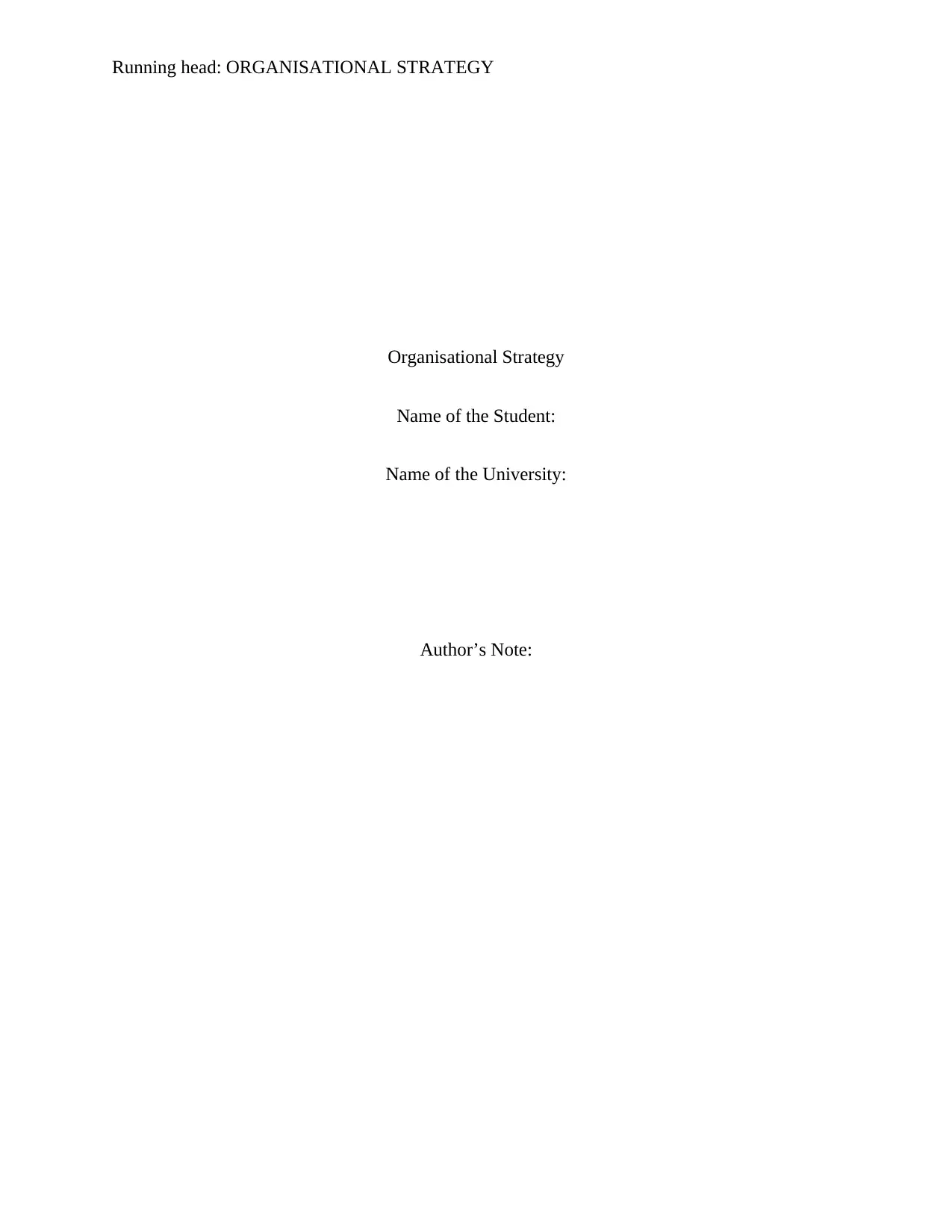
Running head: ORGANISATIONAL STRATEGY
Organisational Strategy
Name of the Student:
Name of the University:
Author’s Note:
Organisational Strategy
Name of the Student:
Name of the University:
Author’s Note:
Secure Best Marks with AI Grader
Need help grading? Try our AI Grader for instant feedback on your assignments.
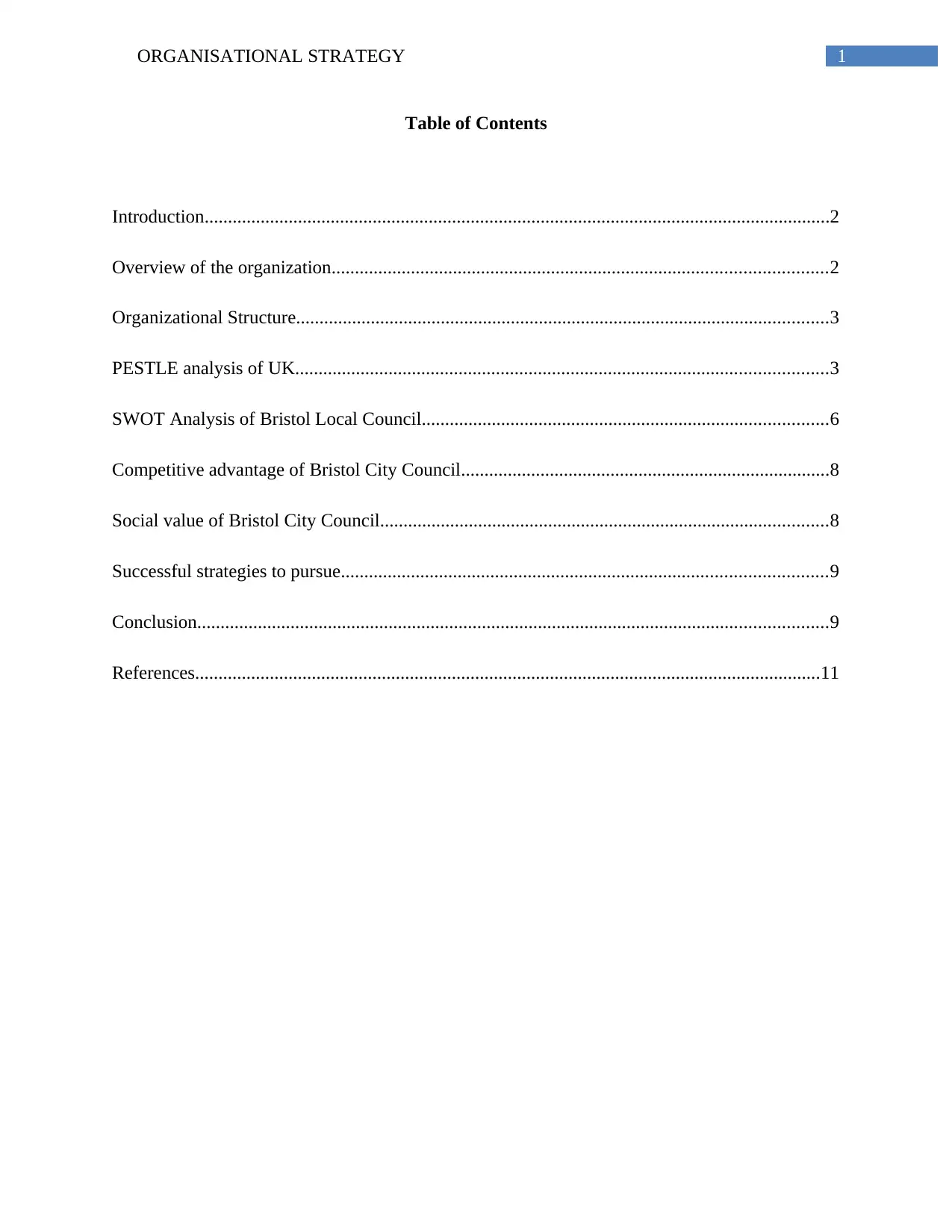
1ORGANISATIONAL STRATEGY
Table of Contents
Introduction......................................................................................................................................2
Overview of the organization..........................................................................................................2
Organizational Structure..................................................................................................................3
PESTLE analysis of UK..................................................................................................................3
SWOT Analysis of Bristol Local Council.......................................................................................6
Competitive advantage of Bristol City Council...............................................................................8
Social value of Bristol City Council................................................................................................8
Successful strategies to pursue........................................................................................................9
Conclusion.......................................................................................................................................9
References......................................................................................................................................11
Table of Contents
Introduction......................................................................................................................................2
Overview of the organization..........................................................................................................2
Organizational Structure..................................................................................................................3
PESTLE analysis of UK..................................................................................................................3
SWOT Analysis of Bristol Local Council.......................................................................................6
Competitive advantage of Bristol City Council...............................................................................8
Social value of Bristol City Council................................................................................................8
Successful strategies to pursue........................................................................................................9
Conclusion.......................................................................................................................................9
References......................................................................................................................................11
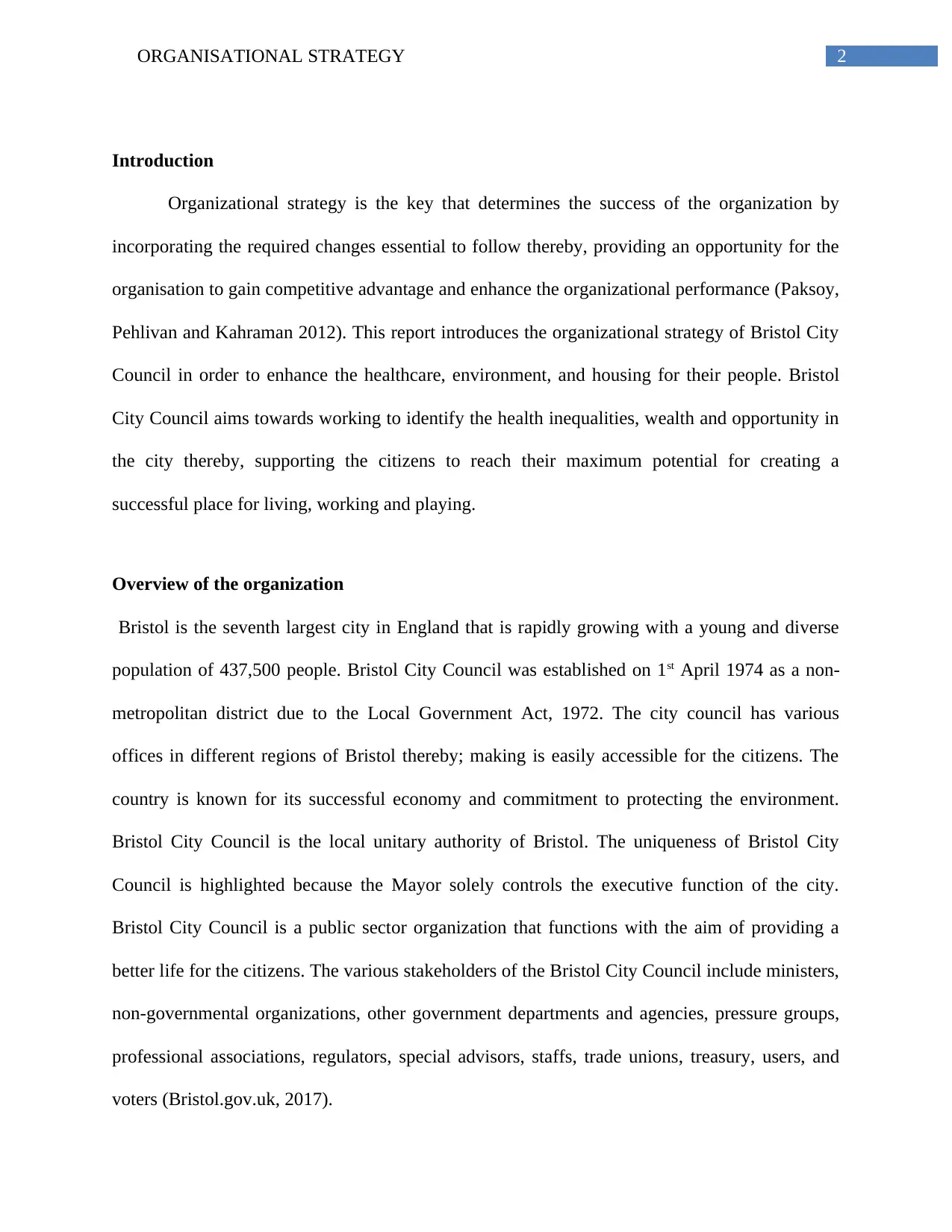
2ORGANISATIONAL STRATEGY
Introduction
Organizational strategy is the key that determines the success of the organization by
incorporating the required changes essential to follow thereby, providing an opportunity for the
organisation to gain competitive advantage and enhance the organizational performance (Paksoy,
Pehlivan and Kahraman 2012). This report introduces the organizational strategy of Bristol City
Council in order to enhance the healthcare, environment, and housing for their people. Bristol
City Council aims towards working to identify the health inequalities, wealth and opportunity in
the city thereby, supporting the citizens to reach their maximum potential for creating a
successful place for living, working and playing.
Overview of the organization
Bristol is the seventh largest city in England that is rapidly growing with a young and diverse
population of 437,500 people. Bristol City Council was established on 1st April 1974 as a non-
metropolitan district due to the Local Government Act, 1972. The city council has various
offices in different regions of Bristol thereby; making is easily accessible for the citizens. The
country is known for its successful economy and commitment to protecting the environment.
Bristol City Council is the local unitary authority of Bristol. The uniqueness of Bristol City
Council is highlighted because the Mayor solely controls the executive function of the city.
Bristol City Council is a public sector organization that functions with the aim of providing a
better life for the citizens. The various stakeholders of the Bristol City Council include ministers,
non-governmental organizations, other government departments and agencies, pressure groups,
professional associations, regulators, special advisors, staffs, trade unions, treasury, users, and
voters (Bristol.gov.uk, 2017).
Introduction
Organizational strategy is the key that determines the success of the organization by
incorporating the required changes essential to follow thereby, providing an opportunity for the
organisation to gain competitive advantage and enhance the organizational performance (Paksoy,
Pehlivan and Kahraman 2012). This report introduces the organizational strategy of Bristol City
Council in order to enhance the healthcare, environment, and housing for their people. Bristol
City Council aims towards working to identify the health inequalities, wealth and opportunity in
the city thereby, supporting the citizens to reach their maximum potential for creating a
successful place for living, working and playing.
Overview of the organization
Bristol is the seventh largest city in England that is rapidly growing with a young and diverse
population of 437,500 people. Bristol City Council was established on 1st April 1974 as a non-
metropolitan district due to the Local Government Act, 1972. The city council has various
offices in different regions of Bristol thereby; making is easily accessible for the citizens. The
country is known for its successful economy and commitment to protecting the environment.
Bristol City Council is the local unitary authority of Bristol. The uniqueness of Bristol City
Council is highlighted because the Mayor solely controls the executive function of the city.
Bristol City Council is a public sector organization that functions with the aim of providing a
better life for the citizens. The various stakeholders of the Bristol City Council include ministers,
non-governmental organizations, other government departments and agencies, pressure groups,
professional associations, regulators, special advisors, staffs, trade unions, treasury, users, and
voters (Bristol.gov.uk, 2017).
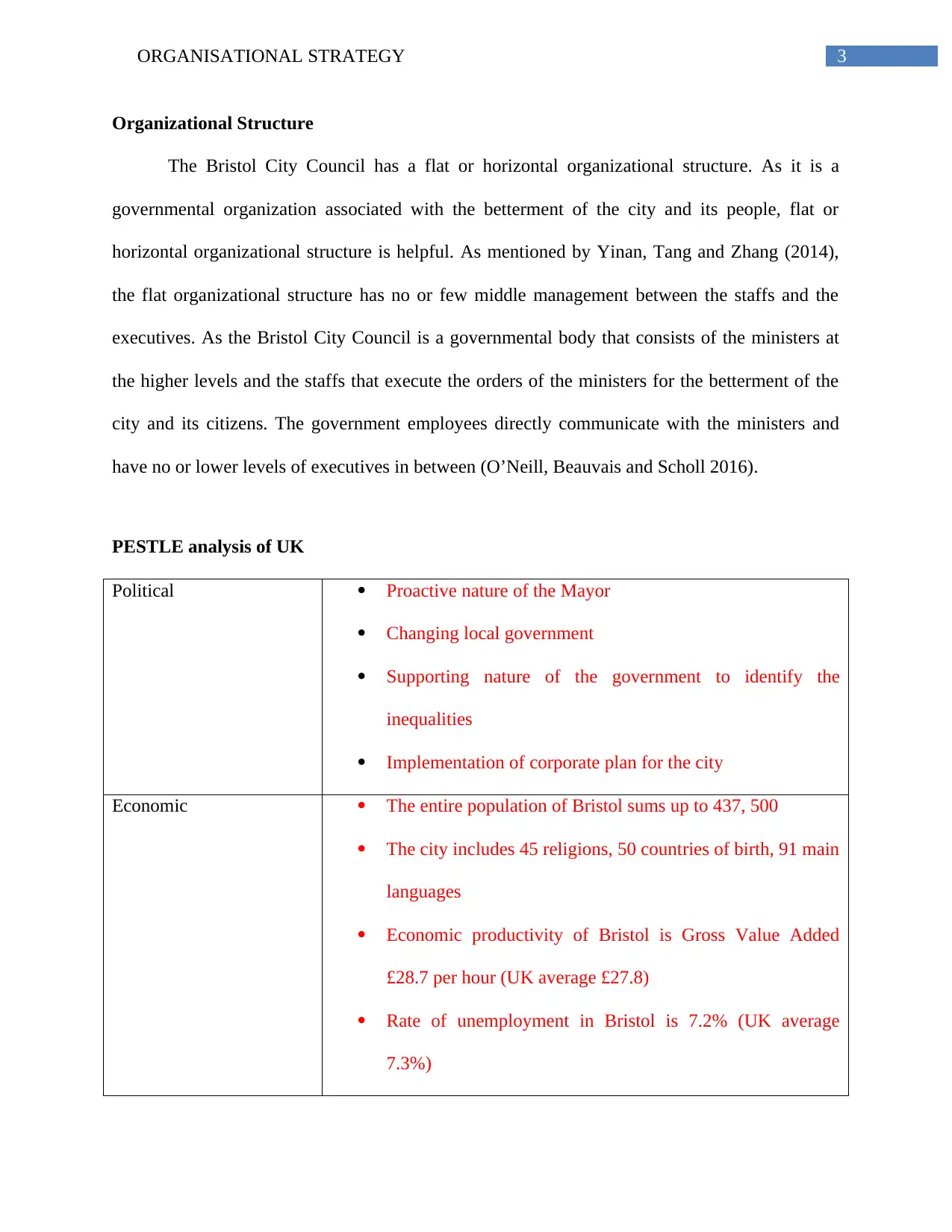
3ORGANISATIONAL STRATEGY
Organizational Structure
The Bristol City Council has a flat or horizontal organizational structure. As it is a
governmental organization associated with the betterment of the city and its people, flat or
horizontal organizational structure is helpful. As mentioned by Yinan, Tang and Zhang (2014),
the flat organizational structure has no or few middle management between the staffs and the
executives. As the Bristol City Council is a governmental body that consists of the ministers at
the higher levels and the staffs that execute the orders of the ministers for the betterment of the
city and its citizens. The government employees directly communicate with the ministers and
have no or lower levels of executives in between (O’Neill, Beauvais and Scholl 2016).
PESTLE analysis of UK
Political Proactive nature of the Mayor
Changing local government
Supporting nature of the government to identify the
inequalities
Implementation of corporate plan for the city
Economic The entire population of Bristol sums up to 437, 500
The city includes 45 religions, 50 countries of birth, 91 main
languages
Economic productivity of Bristol is Gross Value Added
£28.7 per hour (UK average £27.8)
Rate of unemployment in Bristol is 7.2% (UK average
7.3%)
Organizational Structure
The Bristol City Council has a flat or horizontal organizational structure. As it is a
governmental organization associated with the betterment of the city and its people, flat or
horizontal organizational structure is helpful. As mentioned by Yinan, Tang and Zhang (2014),
the flat organizational structure has no or few middle management between the staffs and the
executives. As the Bristol City Council is a governmental body that consists of the ministers at
the higher levels and the staffs that execute the orders of the ministers for the betterment of the
city and its citizens. The government employees directly communicate with the ministers and
have no or lower levels of executives in between (O’Neill, Beauvais and Scholl 2016).
PESTLE analysis of UK
Political Proactive nature of the Mayor
Changing local government
Supporting nature of the government to identify the
inequalities
Implementation of corporate plan for the city
Economic The entire population of Bristol sums up to 437, 500
The city includes 45 religions, 50 countries of birth, 91 main
languages
Economic productivity of Bristol is Gross Value Added
£28.7 per hour (UK average £27.8)
Rate of unemployment in Bristol is 7.2% (UK average
7.3%)
Secure Best Marks with AI Grader
Need help grading? Try our AI Grader for instant feedback on your assignments.
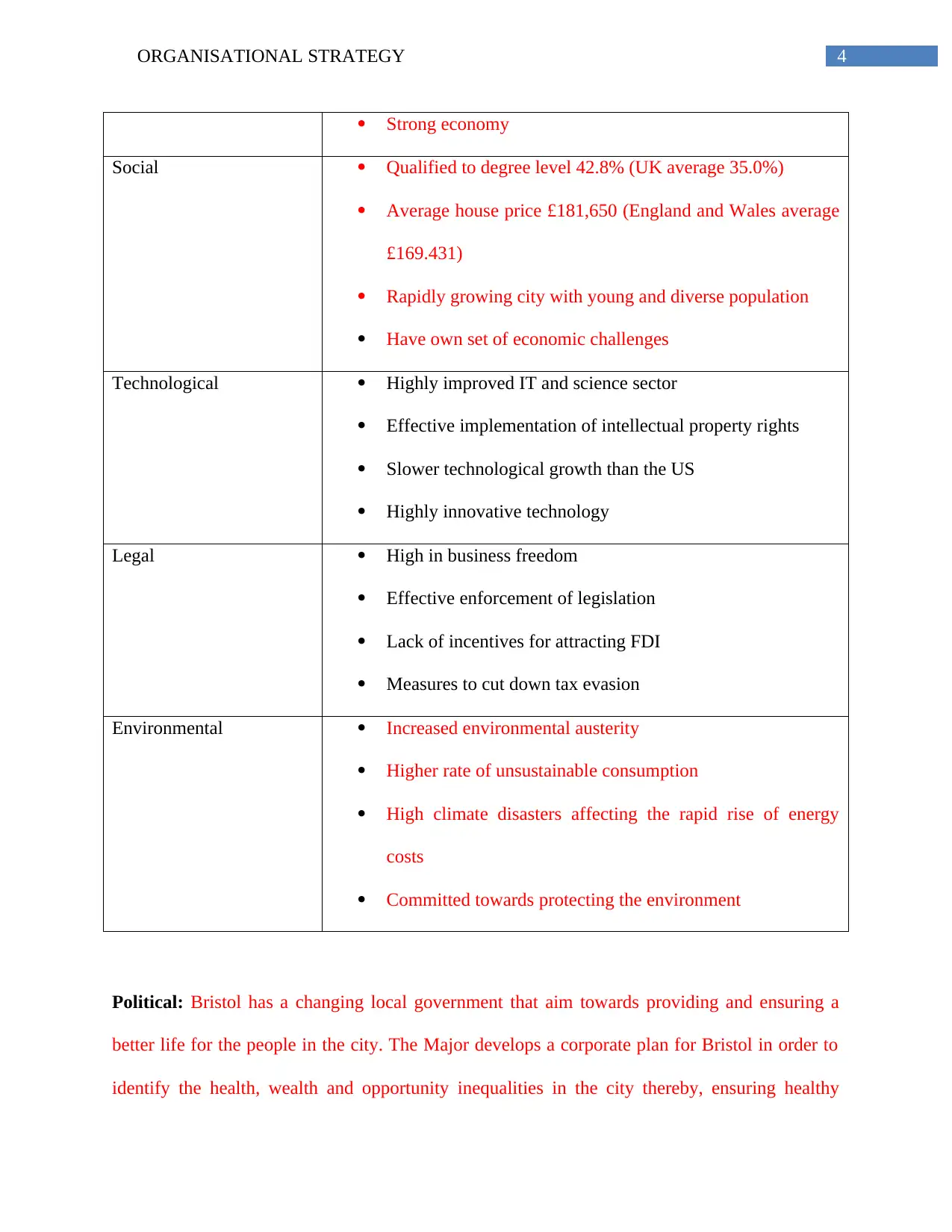
4ORGANISATIONAL STRATEGY
Strong economy
Social Qualified to degree level 42.8% (UK average 35.0%)
Average house price £181,650 (England and Wales average
£169.431)
Rapidly growing city with young and diverse population
Have own set of economic challenges
Technological Highly improved IT and science sector
Effective implementation of intellectual property rights
Slower technological growth than the US
Highly innovative technology
Legal High in business freedom
Effective enforcement of legislation
Lack of incentives for attracting FDI
Measures to cut down tax evasion
Environmental Increased environmental austerity
Higher rate of unsustainable consumption
High climate disasters affecting the rapid rise of energy
costs
Committed towards protecting the environment
Political: Bristol has a changing local government that aim towards providing and ensuring a
better life for the people in the city. The Major develops a corporate plan for Bristol in order to
identify the health, wealth and opportunity inequalities in the city thereby, ensuring healthy
Strong economy
Social Qualified to degree level 42.8% (UK average 35.0%)
Average house price £181,650 (England and Wales average
£169.431)
Rapidly growing city with young and diverse population
Have own set of economic challenges
Technological Highly improved IT and science sector
Effective implementation of intellectual property rights
Slower technological growth than the US
Highly innovative technology
Legal High in business freedom
Effective enforcement of legislation
Lack of incentives for attracting FDI
Measures to cut down tax evasion
Environmental Increased environmental austerity
Higher rate of unsustainable consumption
High climate disasters affecting the rapid rise of energy
costs
Committed towards protecting the environment
Political: Bristol has a changing local government that aim towards providing and ensuring a
better life for the people in the city. The Major develops a corporate plan for Bristol in order to
identify the health, wealth and opportunity inequalities in the city thereby, ensuring healthy
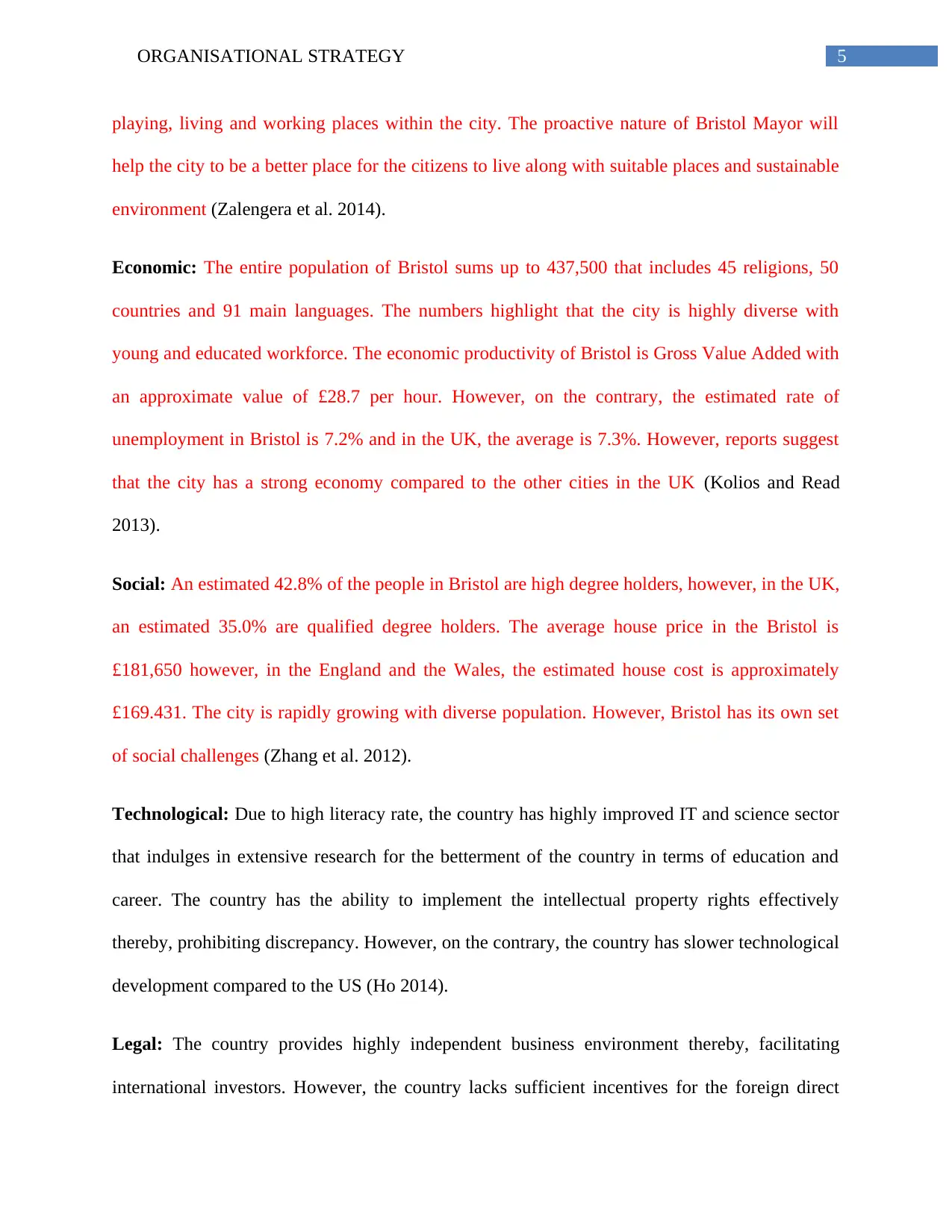
5ORGANISATIONAL STRATEGY
playing, living and working places within the city. The proactive nature of Bristol Mayor will
help the city to be a better place for the citizens to live along with suitable places and sustainable
environment (Zalengera et al. 2014).
Economic: The entire population of Bristol sums up to 437,500 that includes 45 religions, 50
countries and 91 main languages. The numbers highlight that the city is highly diverse with
young and educated workforce. The economic productivity of Bristol is Gross Value Added with
an approximate value of £28.7 per hour. However, on the contrary, the estimated rate of
unemployment in Bristol is 7.2% and in the UK, the average is 7.3%. However, reports suggest
that the city has a strong economy compared to the other cities in the UK (Kolios and Read
2013).
Social: An estimated 42.8% of the people in Bristol are high degree holders, however, in the UK,
an estimated 35.0% are qualified degree holders. The average house price in the Bristol is
£181,650 however, in the England and the Wales, the estimated house cost is approximately
£169.431. The city is rapidly growing with diverse population. However, Bristol has its own set
of social challenges (Zhang et al. 2012).
Technological: Due to high literacy rate, the country has highly improved IT and science sector
that indulges in extensive research for the betterment of the country in terms of education and
career. The country has the ability to implement the intellectual property rights effectively
thereby, prohibiting discrepancy. However, on the contrary, the country has slower technological
development compared to the US (Ho 2014).
Legal: The country provides highly independent business environment thereby, facilitating
international investors. However, the country lacks sufficient incentives for the foreign direct
playing, living and working places within the city. The proactive nature of Bristol Mayor will
help the city to be a better place for the citizens to live along with suitable places and sustainable
environment (Zalengera et al. 2014).
Economic: The entire population of Bristol sums up to 437,500 that includes 45 religions, 50
countries and 91 main languages. The numbers highlight that the city is highly diverse with
young and educated workforce. The economic productivity of Bristol is Gross Value Added with
an approximate value of £28.7 per hour. However, on the contrary, the estimated rate of
unemployment in Bristol is 7.2% and in the UK, the average is 7.3%. However, reports suggest
that the city has a strong economy compared to the other cities in the UK (Kolios and Read
2013).
Social: An estimated 42.8% of the people in Bristol are high degree holders, however, in the UK,
an estimated 35.0% are qualified degree holders. The average house price in the Bristol is
£181,650 however, in the England and the Wales, the estimated house cost is approximately
£169.431. The city is rapidly growing with diverse population. However, Bristol has its own set
of social challenges (Zhang et al. 2012).
Technological: Due to high literacy rate, the country has highly improved IT and science sector
that indulges in extensive research for the betterment of the country in terms of education and
career. The country has the ability to implement the intellectual property rights effectively
thereby, prohibiting discrepancy. However, on the contrary, the country has slower technological
development compared to the US (Ho 2014).
Legal: The country provides highly independent business environment thereby, facilitating
international investors. However, the country lacks sufficient incentives for the foreign direct
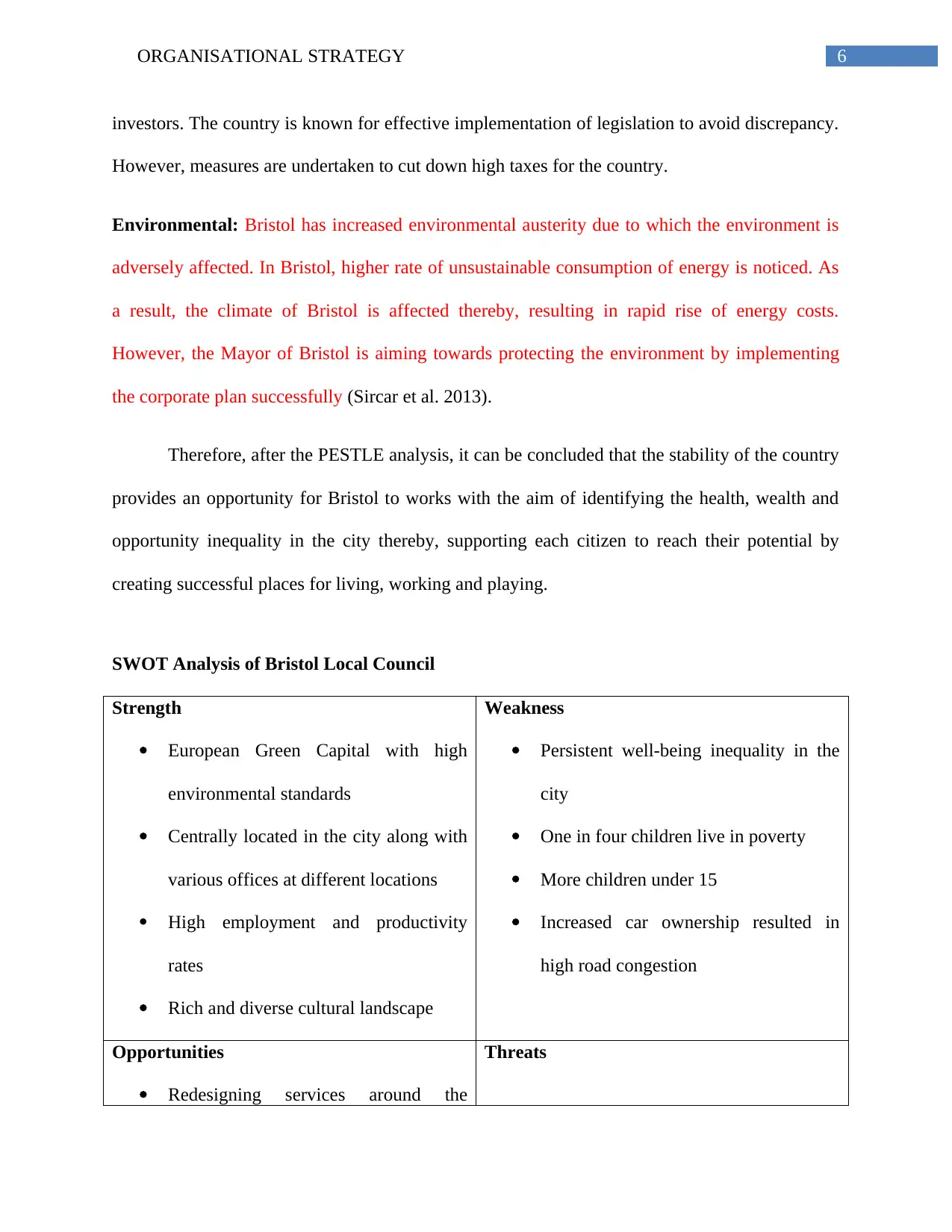
6ORGANISATIONAL STRATEGY
investors. The country is known for effective implementation of legislation to avoid discrepancy.
However, measures are undertaken to cut down high taxes for the country.
Environmental: Bristol has increased environmental austerity due to which the environment is
adversely affected. In Bristol, higher rate of unsustainable consumption of energy is noticed. As
a result, the climate of Bristol is affected thereby, resulting in rapid rise of energy costs.
However, the Mayor of Bristol is aiming towards protecting the environment by implementing
the corporate plan successfully (Sircar et al. 2013).
Therefore, after the PESTLE analysis, it can be concluded that the stability of the country
provides an opportunity for Bristol to works with the aim of identifying the health, wealth and
opportunity inequality in the city thereby, supporting each citizen to reach their potential by
creating successful places for living, working and playing.
SWOT Analysis of Bristol Local Council
Strength
European Green Capital with high
environmental standards
Centrally located in the city along with
various offices at different locations
High employment and productivity
rates
Rich and diverse cultural landscape
Weakness
Persistent well-being inequality in the
city
One in four children live in poverty
More children under 15
Increased car ownership resulted in
high road congestion
Opportunities
Redesigning services around the
Threats
investors. The country is known for effective implementation of legislation to avoid discrepancy.
However, measures are undertaken to cut down high taxes for the country.
Environmental: Bristol has increased environmental austerity due to which the environment is
adversely affected. In Bristol, higher rate of unsustainable consumption of energy is noticed. As
a result, the climate of Bristol is affected thereby, resulting in rapid rise of energy costs.
However, the Mayor of Bristol is aiming towards protecting the environment by implementing
the corporate plan successfully (Sircar et al. 2013).
Therefore, after the PESTLE analysis, it can be concluded that the stability of the country
provides an opportunity for Bristol to works with the aim of identifying the health, wealth and
opportunity inequality in the city thereby, supporting each citizen to reach their potential by
creating successful places for living, working and playing.
SWOT Analysis of Bristol Local Council
Strength
European Green Capital with high
environmental standards
Centrally located in the city along with
various offices at different locations
High employment and productivity
rates
Rich and diverse cultural landscape
Weakness
Persistent well-being inequality in the
city
One in four children live in poverty
More children under 15
Increased car ownership resulted in
high road congestion
Opportunities
Redesigning services around the
Threats
Paraphrase This Document
Need a fresh take? Get an instant paraphrase of this document with our AI Paraphraser
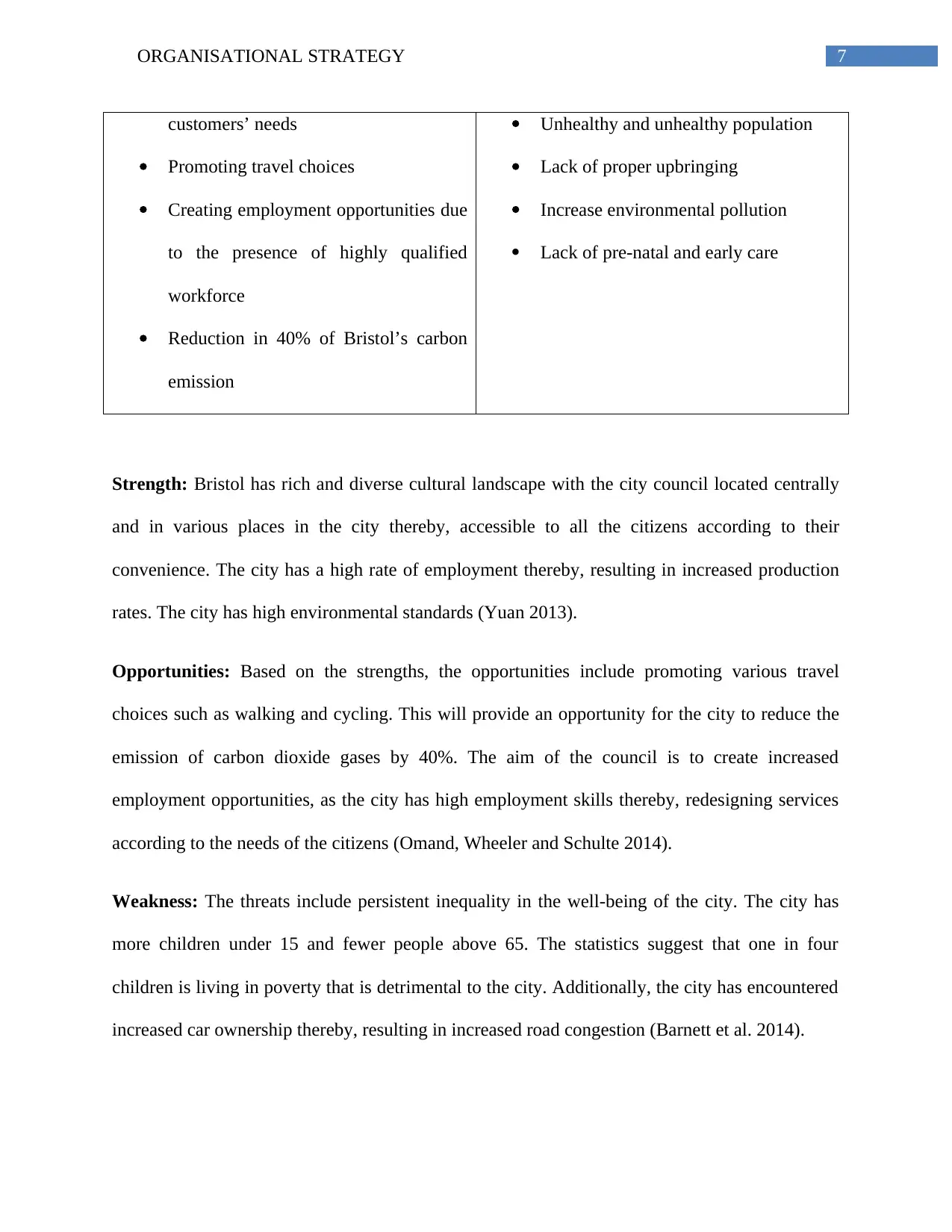
7ORGANISATIONAL STRATEGY
customers’ needs
Promoting travel choices
Creating employment opportunities due
to the presence of highly qualified
workforce
Reduction in 40% of Bristol’s carbon
emission
Unhealthy and unhealthy population
Lack of proper upbringing
Increase environmental pollution
Lack of pre-natal and early care
Strength: Bristol has rich and diverse cultural landscape with the city council located centrally
and in various places in the city thereby, accessible to all the citizens according to their
convenience. The city has a high rate of employment thereby, resulting in increased production
rates. The city has high environmental standards (Yuan 2013).
Opportunities: Based on the strengths, the opportunities include promoting various travel
choices such as walking and cycling. This will provide an opportunity for the city to reduce the
emission of carbon dioxide gases by 40%. The aim of the council is to create increased
employment opportunities, as the city has high employment skills thereby, redesigning services
according to the needs of the citizens (Omand, Wheeler and Schulte 2014).
Weakness: The threats include persistent inequality in the well-being of the city. The city has
more children under 15 and fewer people above 65. The statistics suggest that one in four
children is living in poverty that is detrimental to the city. Additionally, the city has encountered
increased car ownership thereby, resulting in increased road congestion (Barnett et al. 2014).
customers’ needs
Promoting travel choices
Creating employment opportunities due
to the presence of highly qualified
workforce
Reduction in 40% of Bristol’s carbon
emission
Unhealthy and unhealthy population
Lack of proper upbringing
Increase environmental pollution
Lack of pre-natal and early care
Strength: Bristol has rich and diverse cultural landscape with the city council located centrally
and in various places in the city thereby, accessible to all the citizens according to their
convenience. The city has a high rate of employment thereby, resulting in increased production
rates. The city has high environmental standards (Yuan 2013).
Opportunities: Based on the strengths, the opportunities include promoting various travel
choices such as walking and cycling. This will provide an opportunity for the city to reduce the
emission of carbon dioxide gases by 40%. The aim of the council is to create increased
employment opportunities, as the city has high employment skills thereby, redesigning services
according to the needs of the citizens (Omand, Wheeler and Schulte 2014).
Weakness: The threats include persistent inequality in the well-being of the city. The city has
more children under 15 and fewer people above 65. The statistics suggest that one in four
children is living in poverty that is detrimental to the city. Additionally, the city has encountered
increased car ownership thereby, resulting in increased road congestion (Barnett et al. 2014).
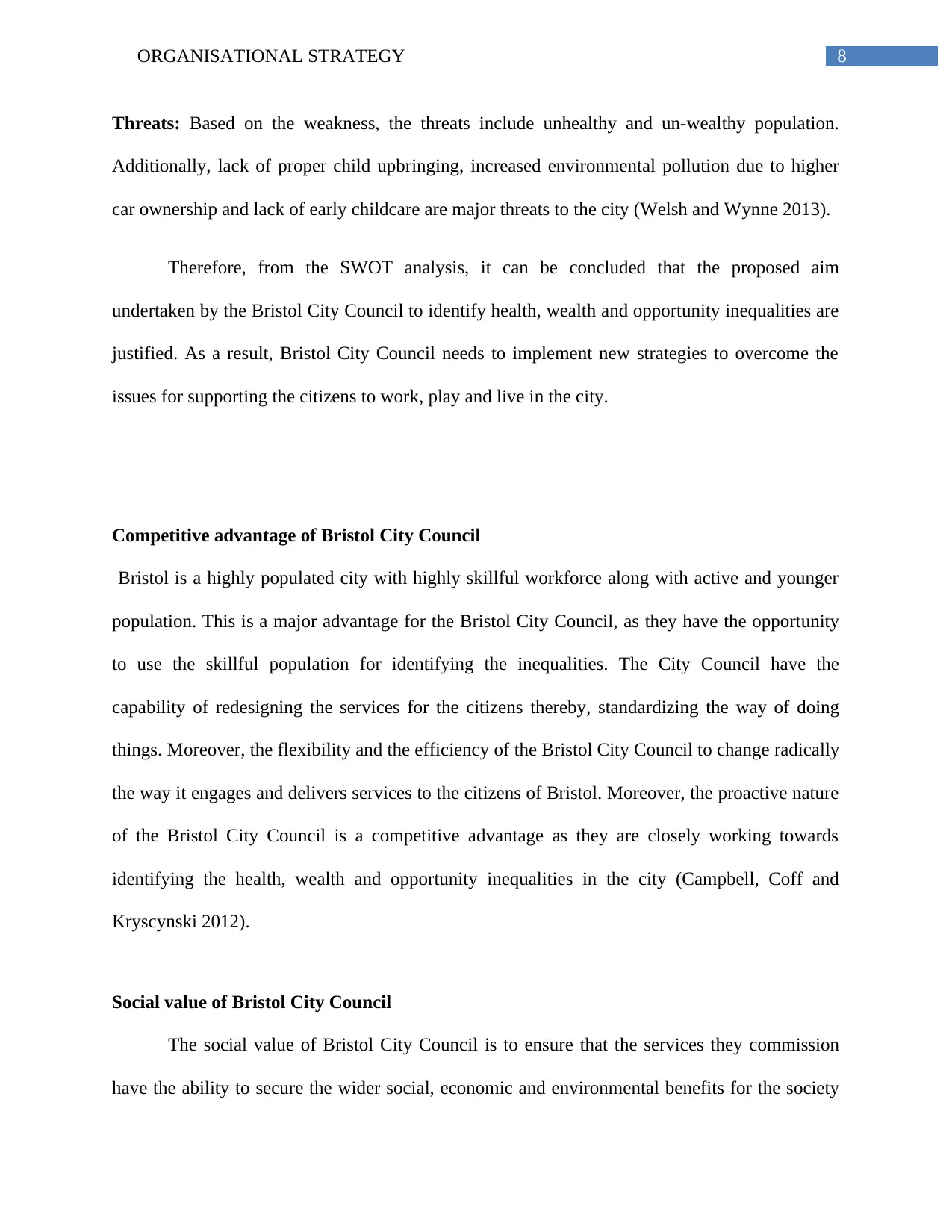
8ORGANISATIONAL STRATEGY
Threats: Based on the weakness, the threats include unhealthy and un-wealthy population.
Additionally, lack of proper child upbringing, increased environmental pollution due to higher
car ownership and lack of early childcare are major threats to the city (Welsh and Wynne 2013).
Therefore, from the SWOT analysis, it can be concluded that the proposed aim
undertaken by the Bristol City Council to identify health, wealth and opportunity inequalities are
justified. As a result, Bristol City Council needs to implement new strategies to overcome the
issues for supporting the citizens to work, play and live in the city.
Competitive advantage of Bristol City Council
Bristol is a highly populated city with highly skillful workforce along with active and younger
population. This is a major advantage for the Bristol City Council, as they have the opportunity
to use the skillful population for identifying the inequalities. The City Council have the
capability of redesigning the services for the citizens thereby, standardizing the way of doing
things. Moreover, the flexibility and the efficiency of the Bristol City Council to change radically
the way it engages and delivers services to the citizens of Bristol. Moreover, the proactive nature
of the Bristol City Council is a competitive advantage as they are closely working towards
identifying the health, wealth and opportunity inequalities in the city (Campbell, Coff and
Kryscynski 2012).
Social value of Bristol City Council
The social value of Bristol City Council is to ensure that the services they commission
have the ability to secure the wider social, economic and environmental benefits for the society
Threats: Based on the weakness, the threats include unhealthy and un-wealthy population.
Additionally, lack of proper child upbringing, increased environmental pollution due to higher
car ownership and lack of early childcare are major threats to the city (Welsh and Wynne 2013).
Therefore, from the SWOT analysis, it can be concluded that the proposed aim
undertaken by the Bristol City Council to identify health, wealth and opportunity inequalities are
justified. As a result, Bristol City Council needs to implement new strategies to overcome the
issues for supporting the citizens to work, play and live in the city.
Competitive advantage of Bristol City Council
Bristol is a highly populated city with highly skillful workforce along with active and younger
population. This is a major advantage for the Bristol City Council, as they have the opportunity
to use the skillful population for identifying the inequalities. The City Council have the
capability of redesigning the services for the citizens thereby, standardizing the way of doing
things. Moreover, the flexibility and the efficiency of the Bristol City Council to change radically
the way it engages and delivers services to the citizens of Bristol. Moreover, the proactive nature
of the Bristol City Council is a competitive advantage as they are closely working towards
identifying the health, wealth and opportunity inequalities in the city (Campbell, Coff and
Kryscynski 2012).
Social value of Bristol City Council
The social value of Bristol City Council is to ensure that the services they commission
have the ability to secure the wider social, economic and environmental benefits for the society
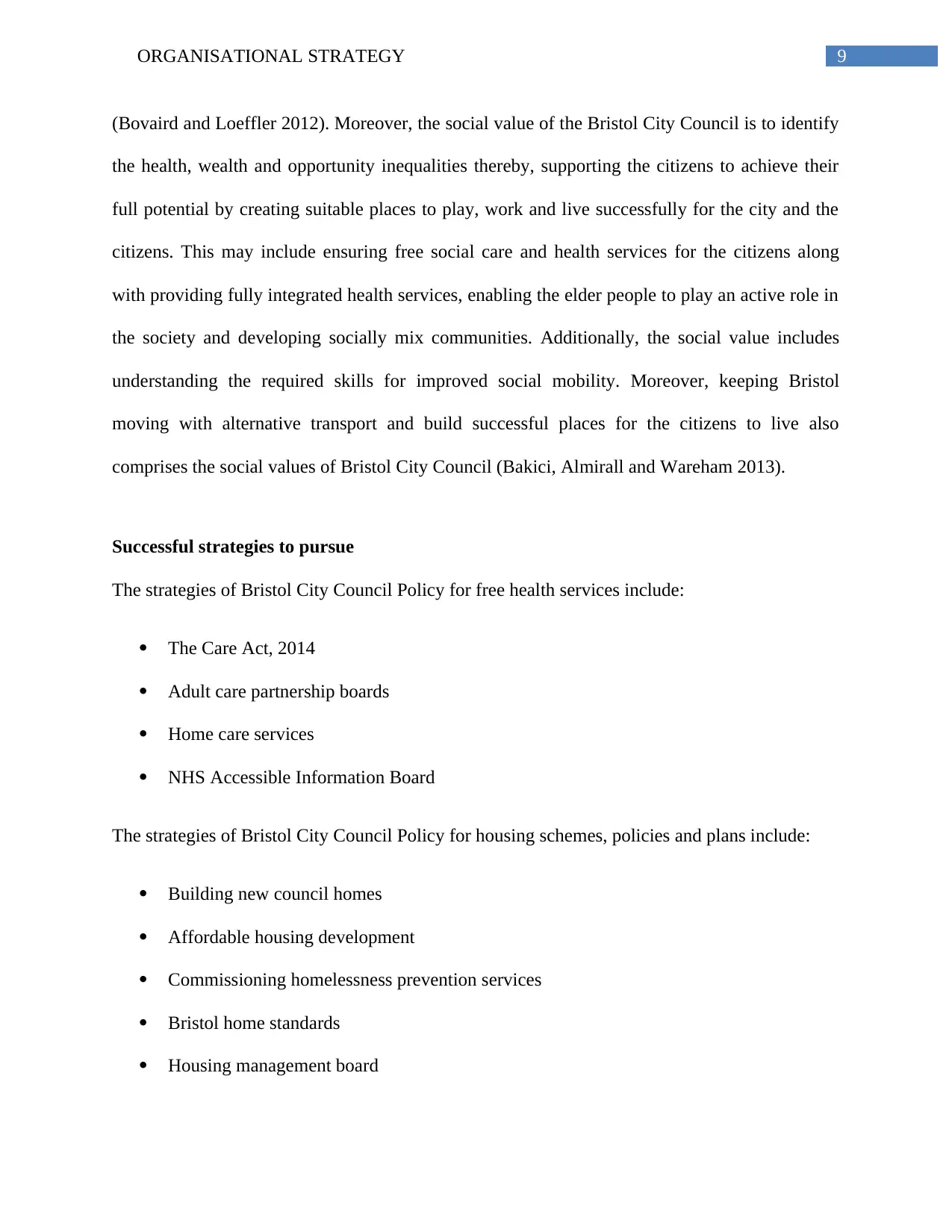
9ORGANISATIONAL STRATEGY
(Bovaird and Loeffler 2012). Moreover, the social value of the Bristol City Council is to identify
the health, wealth and opportunity inequalities thereby, supporting the citizens to achieve their
full potential by creating suitable places to play, work and live successfully for the city and the
citizens. This may include ensuring free social care and health services for the citizens along
with providing fully integrated health services, enabling the elder people to play an active role in
the society and developing socially mix communities. Additionally, the social value includes
understanding the required skills for improved social mobility. Moreover, keeping Bristol
moving with alternative transport and build successful places for the citizens to live also
comprises the social values of Bristol City Council (Bakici, Almirall and Wareham 2013).
Successful strategies to pursue
The strategies of Bristol City Council Policy for free health services include:
The Care Act, 2014
Adult care partnership boards
Home care services
NHS Accessible Information Board
The strategies of Bristol City Council Policy for housing schemes, policies and plans include:
Building new council homes
Affordable housing development
Commissioning homelessness prevention services
Bristol home standards
Housing management board
(Bovaird and Loeffler 2012). Moreover, the social value of the Bristol City Council is to identify
the health, wealth and opportunity inequalities thereby, supporting the citizens to achieve their
full potential by creating suitable places to play, work and live successfully for the city and the
citizens. This may include ensuring free social care and health services for the citizens along
with providing fully integrated health services, enabling the elder people to play an active role in
the society and developing socially mix communities. Additionally, the social value includes
understanding the required skills for improved social mobility. Moreover, keeping Bristol
moving with alternative transport and build successful places for the citizens to live also
comprises the social values of Bristol City Council (Bakici, Almirall and Wareham 2013).
Successful strategies to pursue
The strategies of Bristol City Council Policy for free health services include:
The Care Act, 2014
Adult care partnership boards
Home care services
NHS Accessible Information Board
The strategies of Bristol City Council Policy for housing schemes, policies and plans include:
Building new council homes
Affordable housing development
Commissioning homelessness prevention services
Bristol home standards
Housing management board
Secure Best Marks with AI Grader
Need help grading? Try our AI Grader for instant feedback on your assignments.
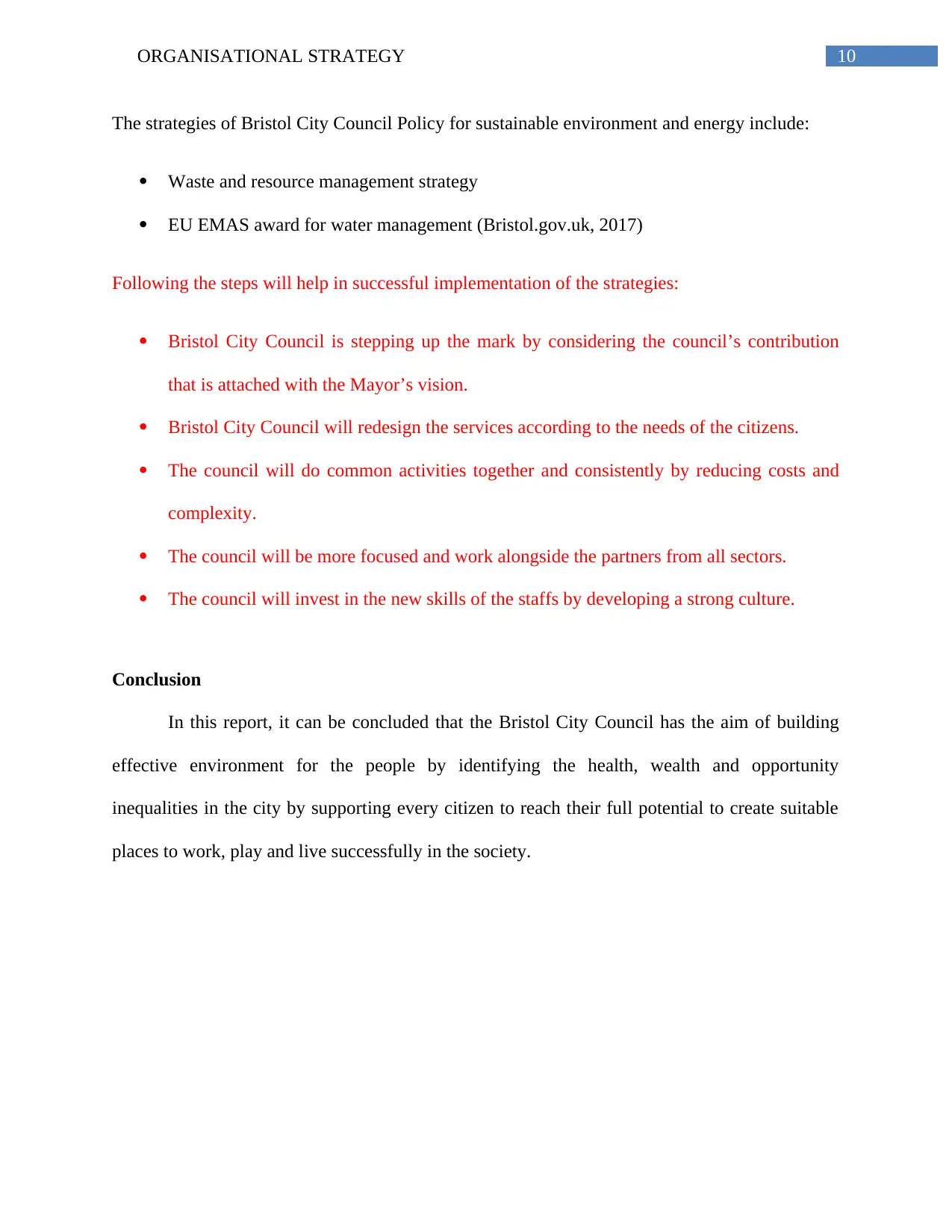
10ORGANISATIONAL STRATEGY
The strategies of Bristol City Council Policy for sustainable environment and energy include:
Waste and resource management strategy
EU EMAS award for water management (Bristol.gov.uk, 2017)
Following the steps will help in successful implementation of the strategies:
Bristol City Council is stepping up the mark by considering the council’s contribution
that is attached with the Mayor’s vision.
Bristol City Council will redesign the services according to the needs of the citizens.
The council will do common activities together and consistently by reducing costs and
complexity.
The council will be more focused and work alongside the partners from all sectors.
The council will invest in the new skills of the staffs by developing a strong culture.
Conclusion
In this report, it can be concluded that the Bristol City Council has the aim of building
effective environment for the people by identifying the health, wealth and opportunity
inequalities in the city by supporting every citizen to reach their full potential to create suitable
places to work, play and live successfully in the society.
The strategies of Bristol City Council Policy for sustainable environment and energy include:
Waste and resource management strategy
EU EMAS award for water management (Bristol.gov.uk, 2017)
Following the steps will help in successful implementation of the strategies:
Bristol City Council is stepping up the mark by considering the council’s contribution
that is attached with the Mayor’s vision.
Bristol City Council will redesign the services according to the needs of the citizens.
The council will do common activities together and consistently by reducing costs and
complexity.
The council will be more focused and work alongside the partners from all sectors.
The council will invest in the new skills of the staffs by developing a strong culture.
Conclusion
In this report, it can be concluded that the Bristol City Council has the aim of building
effective environment for the people by identifying the health, wealth and opportunity
inequalities in the city by supporting every citizen to reach their full potential to create suitable
places to work, play and live successfully in the society.
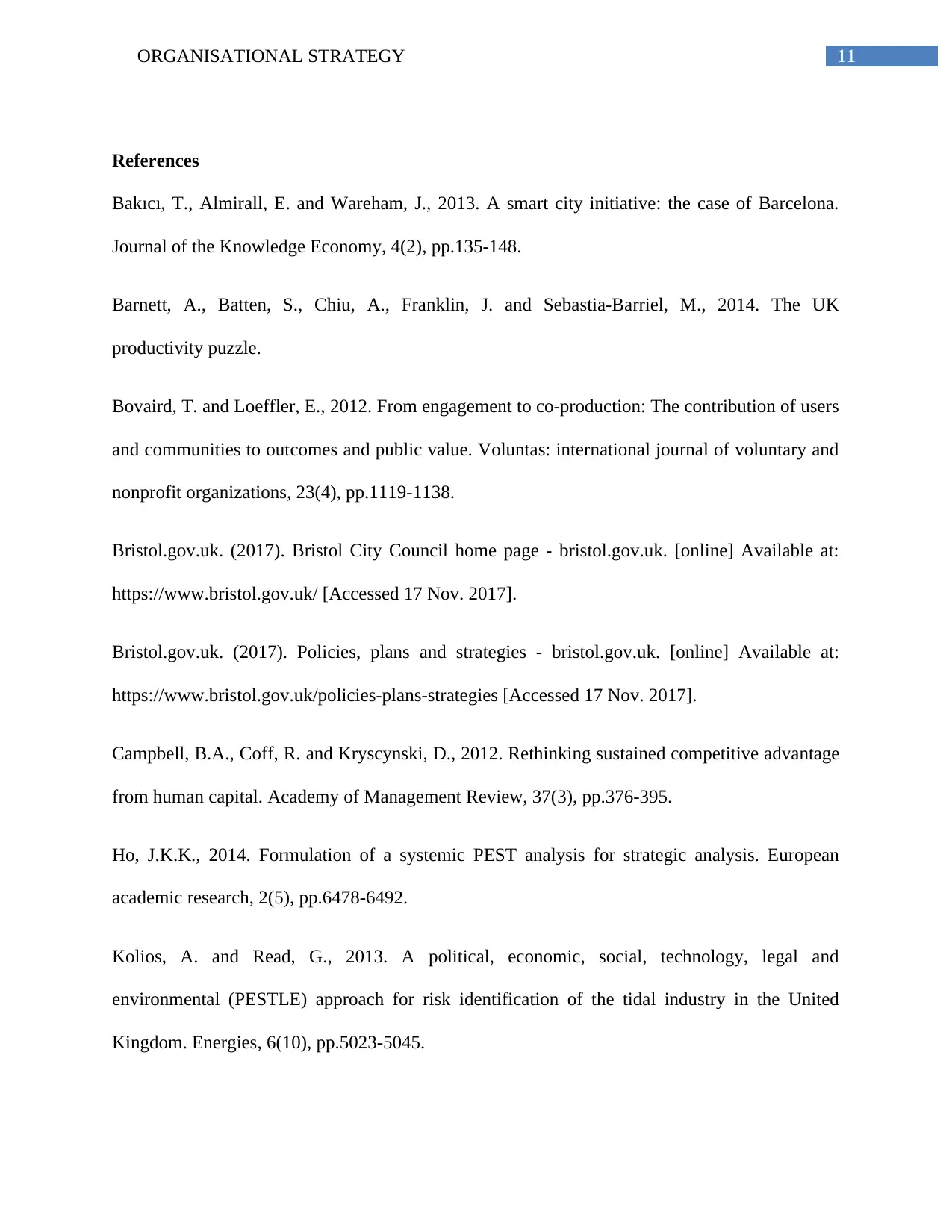
11ORGANISATIONAL STRATEGY
References
Bakıcı, T., Almirall, E. and Wareham, J., 2013. A smart city initiative: the case of Barcelona.
Journal of the Knowledge Economy, 4(2), pp.135-148.
Barnett, A., Batten, S., Chiu, A., Franklin, J. and Sebastia-Barriel, M., 2014. The UK
productivity puzzle.
Bovaird, T. and Loeffler, E., 2012. From engagement to co-production: The contribution of users
and communities to outcomes and public value. Voluntas: international journal of voluntary and
nonprofit organizations, 23(4), pp.1119-1138.
Bristol.gov.uk. (2017). Bristol City Council home page - bristol.gov.uk. [online] Available at:
https://www.bristol.gov.uk/ [Accessed 17 Nov. 2017].
Bristol.gov.uk. (2017). Policies, plans and strategies - bristol.gov.uk. [online] Available at:
https://www.bristol.gov.uk/policies-plans-strategies [Accessed 17 Nov. 2017].
Campbell, B.A., Coff, R. and Kryscynski, D., 2012. Rethinking sustained competitive advantage
from human capital. Academy of Management Review, 37(3), pp.376-395.
Ho, J.K.K., 2014. Formulation of a systemic PEST analysis for strategic analysis. European
academic research, 2(5), pp.6478-6492.
Kolios, A. and Read, G., 2013. A political, economic, social, technology, legal and
environmental (PESTLE) approach for risk identification of the tidal industry in the United
Kingdom. Energies, 6(10), pp.5023-5045.
References
Bakıcı, T., Almirall, E. and Wareham, J., 2013. A smart city initiative: the case of Barcelona.
Journal of the Knowledge Economy, 4(2), pp.135-148.
Barnett, A., Batten, S., Chiu, A., Franklin, J. and Sebastia-Barriel, M., 2014. The UK
productivity puzzle.
Bovaird, T. and Loeffler, E., 2012. From engagement to co-production: The contribution of users
and communities to outcomes and public value. Voluntas: international journal of voluntary and
nonprofit organizations, 23(4), pp.1119-1138.
Bristol.gov.uk. (2017). Bristol City Council home page - bristol.gov.uk. [online] Available at:
https://www.bristol.gov.uk/ [Accessed 17 Nov. 2017].
Bristol.gov.uk. (2017). Policies, plans and strategies - bristol.gov.uk. [online] Available at:
https://www.bristol.gov.uk/policies-plans-strategies [Accessed 17 Nov. 2017].
Campbell, B.A., Coff, R. and Kryscynski, D., 2012. Rethinking sustained competitive advantage
from human capital. Academy of Management Review, 37(3), pp.376-395.
Ho, J.K.K., 2014. Formulation of a systemic PEST analysis for strategic analysis. European
academic research, 2(5), pp.6478-6492.
Kolios, A. and Read, G., 2013. A political, economic, social, technology, legal and
environmental (PESTLE) approach for risk identification of the tidal industry in the United
Kingdom. Energies, 6(10), pp.5023-5045.
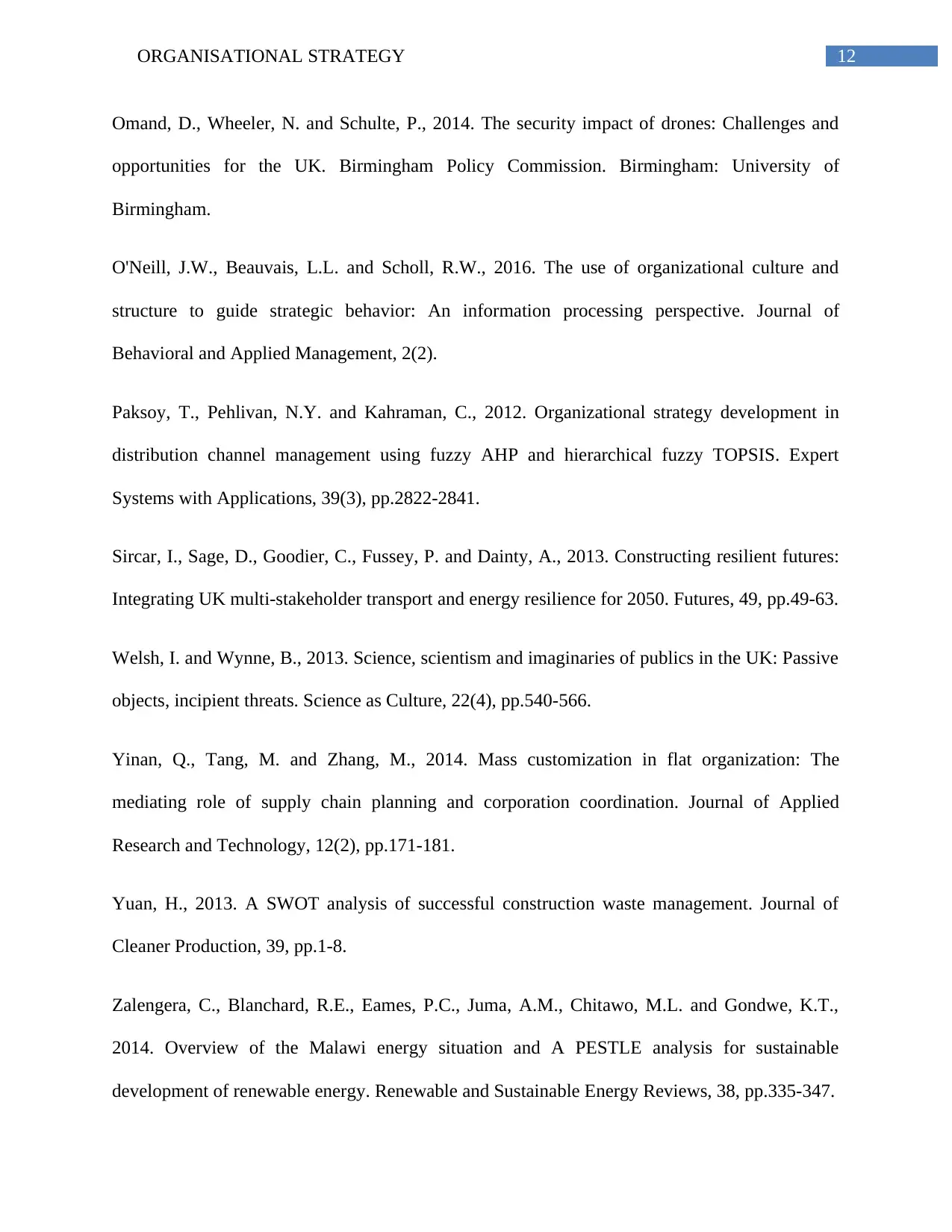
12ORGANISATIONAL STRATEGY
Omand, D., Wheeler, N. and Schulte, P., 2014. The security impact of drones: Challenges and
opportunities for the UK. Birmingham Policy Commission. Birmingham: University of
Birmingham.
O'Neill, J.W., Beauvais, L.L. and Scholl, R.W., 2016. The use of organizational culture and
structure to guide strategic behavior: An information processing perspective. Journal of
Behavioral and Applied Management, 2(2).
Paksoy, T., Pehlivan, N.Y. and Kahraman, C., 2012. Organizational strategy development in
distribution channel management using fuzzy AHP and hierarchical fuzzy TOPSIS. Expert
Systems with Applications, 39(3), pp.2822-2841.
Sircar, I., Sage, D., Goodier, C., Fussey, P. and Dainty, A., 2013. Constructing resilient futures:
Integrating UK multi-stakeholder transport and energy resilience for 2050. Futures, 49, pp.49-63.
Welsh, I. and Wynne, B., 2013. Science, scientism and imaginaries of publics in the UK: Passive
objects, incipient threats. Science as Culture, 22(4), pp.540-566.
Yinan, Q., Tang, M. and Zhang, M., 2014. Mass customization in flat organization: The
mediating role of supply chain planning and corporation coordination. Journal of Applied
Research and Technology, 12(2), pp.171-181.
Yuan, H., 2013. A SWOT analysis of successful construction waste management. Journal of
Cleaner Production, 39, pp.1-8.
Zalengera, C., Blanchard, R.E., Eames, P.C., Juma, A.M., Chitawo, M.L. and Gondwe, K.T.,
2014. Overview of the Malawi energy situation and A PESTLE analysis for sustainable
development of renewable energy. Renewable and Sustainable Energy Reviews, 38, pp.335-347.
Omand, D., Wheeler, N. and Schulte, P., 2014. The security impact of drones: Challenges and
opportunities for the UK. Birmingham Policy Commission. Birmingham: University of
Birmingham.
O'Neill, J.W., Beauvais, L.L. and Scholl, R.W., 2016. The use of organizational culture and
structure to guide strategic behavior: An information processing perspective. Journal of
Behavioral and Applied Management, 2(2).
Paksoy, T., Pehlivan, N.Y. and Kahraman, C., 2012. Organizational strategy development in
distribution channel management using fuzzy AHP and hierarchical fuzzy TOPSIS. Expert
Systems with Applications, 39(3), pp.2822-2841.
Sircar, I., Sage, D., Goodier, C., Fussey, P. and Dainty, A., 2013. Constructing resilient futures:
Integrating UK multi-stakeholder transport and energy resilience for 2050. Futures, 49, pp.49-63.
Welsh, I. and Wynne, B., 2013. Science, scientism and imaginaries of publics in the UK: Passive
objects, incipient threats. Science as Culture, 22(4), pp.540-566.
Yinan, Q., Tang, M. and Zhang, M., 2014. Mass customization in flat organization: The
mediating role of supply chain planning and corporation coordination. Journal of Applied
Research and Technology, 12(2), pp.171-181.
Yuan, H., 2013. A SWOT analysis of successful construction waste management. Journal of
Cleaner Production, 39, pp.1-8.
Zalengera, C., Blanchard, R.E., Eames, P.C., Juma, A.M., Chitawo, M.L. and Gondwe, K.T.,
2014. Overview of the Malawi energy situation and A PESTLE analysis for sustainable
development of renewable energy. Renewable and Sustainable Energy Reviews, 38, pp.335-347.
1 out of 13
Your All-in-One AI-Powered Toolkit for Academic Success.
+13062052269
info@desklib.com
Available 24*7 on WhatsApp / Email
![[object Object]](/_next/static/media/star-bottom.7253800d.svg)
Unlock your academic potential
© 2024 | Zucol Services PVT LTD | All rights reserved.

